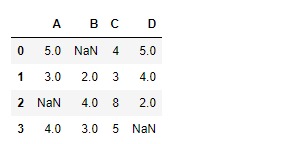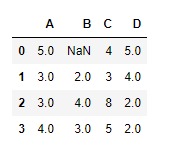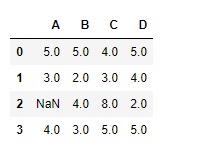Python是进行数据分析的一种出色语言,主要是因为以数据为中心的python软件包具有奇妙的生态系统。 Pandas是其中的一种,使导入和分析数据更加容易。
Pandas dataframe.ffill()函数用于填充 DataFrame 中的缺失值。 “填充”代表“向前填充”,并将向前传播最后一个有效观察值。
用法: DataFrame.ffill(axis=None, inplace=False, limit=None, downcast=None)
参数:
axis:{0,索引1,栏}
inplace:如果为True,则填写。注意:这将修改此对象的任何其他视图(例如,DataFrame中列的no-copy切片)。
limit:如果指定了method,则这是要向前/向后填充的连续NaN值的最大数量。换句话说,如果存在连续的NaN数量大于此数量的缺口,它将仅被部分填充。如果未指定method,则这是将填写NaN的整个轴上的最大条目数。如果不为None,则必须大于0。
Downcast:item-> dtype决定是否向下转换的内容,或字符串“ infer”将尝试向下转换为适当的相等类型(例如,如果可能,将float64转换为int64)
返回:fill:DataFrame
范例1:采用ffill()函数沿索引轴填充缺失值。
注意:什么时候ffill()在索引上应用,然后根据上一行中的相应值填充所有缺失值。
# importing pandas as pd
import pandas as pd
# Creating the dataframe
df=pd.DataFrame({"A":[5,3,None,4],
"B":[None,2,4,3],
"C":[4,3,8,5],
"D":[5,4,2,None]})
# Print the dataframe
df
让我们在索引轴上填充缺失值
# applying ffill() method to fill the missing values
df.ffill(axis = 0)输出:

请注意,第一行中的值仍然NaN值,因为它上方没有行可以传播非NA值。
范例2:采用ffill()函数沿列轴填充缺失值。
注意:当在列轴上应用填充时,缺少的值将由同一行中前一列中的值填充。
# importing pandas as pd
import pandas as pd
# Creating the dataframe
df=pd.DataFrame({"A":[5,3,None,4],
"B":[None,2,4,3],
"C":[4,3,8,5],
"D":[5,4,2,None]})
# Print the dataframe
df
让我们在列轴上填充缺失值
# applying ffill() method to fill the missing values
df.ffill(axis = 1)输出:

请注意,第一栏中的vlaues是NaN值,因为没有剩余单元格,因此无法使用沿列轴的先前单元格值来填充此单元格。
相关用法
- Python pandas.map()用法及代码示例
- Python Pandas Series.str.len()用法及代码示例
- Python Pandas.factorize()用法及代码示例
- Python Pandas TimedeltaIndex.name用法及代码示例
- Python Pandas dataframe.ne()用法及代码示例
- Python Pandas Series.between()用法及代码示例
- Python Pandas DataFrame.where()用法及代码示例
- Python Pandas Series.add()用法及代码示例
- Python Pandas.pivot_table()用法及代码示例
- Python Pandas Series.mod()用法及代码示例
- Python Pandas Dataframe.at[ ]用法及代码示例
- Python Pandas Dataframe.iat[ ]用法及代码示例
- Python Pandas.pivot()用法及代码示例
- Python Pandas dataframe.mul()用法及代码示例
- Python Pandas.melt()用法及代码示例
注:本文由纯净天空筛选整理自Shubham__Ranjan大神的英文原创作品 Python | Pandas dataframe.ffill()。非经特殊声明,原始代码版权归原作者所有,本译文未经允许或授权,请勿转载或复制。
